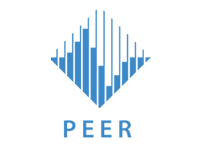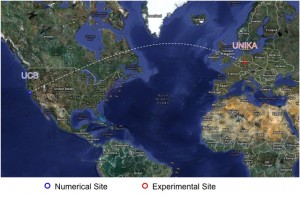
Map showing the research sites that participated in this Continuous Intercontinental Hybrid Simulation Test.
OpenFresco was used to conduct continuous geographically distributed hybrid simulations between the NEES facility at UC Berkeley (nees@berkeley) in the United States and the civil engineering laboratory at the University of Kassel (UNIKA) in Germany.
The experimental substructure of the test consisted of a friction device, named UHYDE-fbr [1], developed by Professor Uwe Dorka of UNIKA (mainly utilized for providing energy dissipation in bridge type structures), and a fixed Tuned-Mass-Damper (TMD). The computational portion of the hybrid model consisted of a single degree of freedom mass with viscous damping. Computations were executed at UC Berkeley and the experimental substructure was located at the University of Kassel. These computations were conducted using a custom-made program, developed by Ferran Obón. This program adapts Dorka’s sub-structure algorithm [2-7] so that it is able to perform distributed tests.
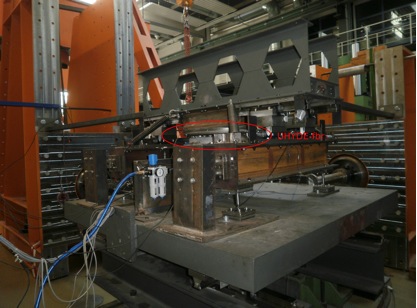
Test set-up at the University of Kassel in Germany showing the friction device, named UHYDE-fbr.
The communication between the computational platform and the test structure was made possible by using OpenFresco. For the purpose of this test, a new generic experimental control was implemented into OpenFresco by Andreas Schellenberg of UC Berkeley. Based on preliminary tests, the average network communication time was determined to be around 0.2 seconds. Communications between UC Berkeley and the University of Kassel were executed over a 1 gigabit network. Given the uncertainty in network communication speeds, the simulation time step was set at 1 second. The integration time step was 0.01 seconds, resulting in a test 100 times slower than real time. Due to the nature of Dorka’s substructure algorithm, the actuators never stopped moving. This resulted in a continuous intercontinental geographically distributed test.
More information can be found in this summary document (5 MB, pdf file).
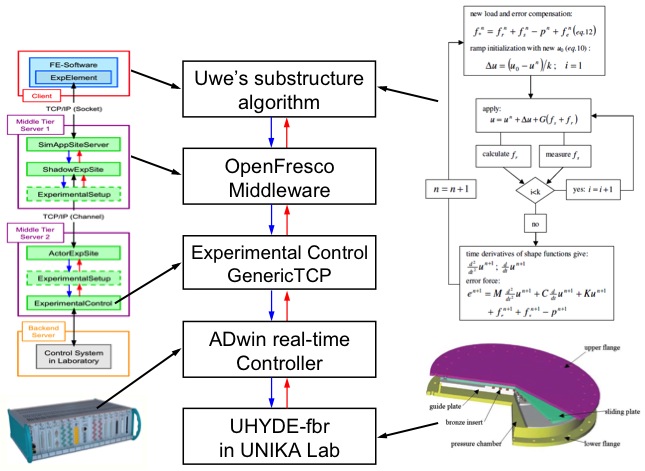
Diagram of the interaction between various test components using the OpenFresco framework.
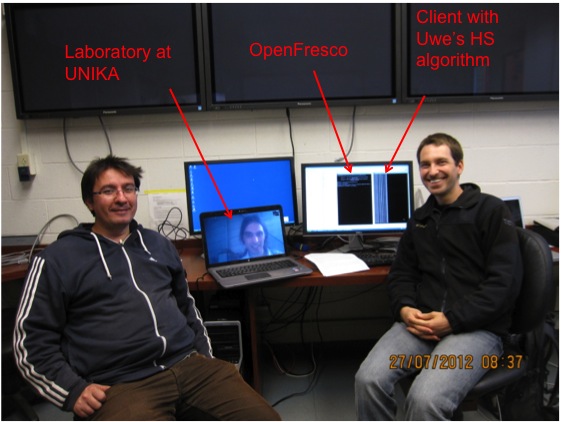
The testing team of Dr. Selim Gunnay (left) and Dr. Andreas Schellenberg (right) at UC Berkeley’s nees@berkeley laboratory, pose for a photo with Dr. Ferran Obón (center) who is virtually present from the civil engineering laboratory at the University of Kassel (UNIKA) in Germany.
[1] Dorka, U.E. (1995) Friction Device for protection of structural systems against dynamic actions, Patent Number 5456047. United States Patent.
[2] Dorka, U.E. and Heiland, D. (1991). “Fast online earthquake simulation using a novel pc supported measurement and control concept”. Proceedings of 4th Int. Conf. Structural Dynamics, Southhampton: 636-645.
[3] Dorka, U.E. and Füllekrug, U. (1998). Report of DFG-project No. Do 360/7: Sub-PSD Test. University of Kaiserlautern, Germany.
[4] Dorka U.E. (2002), “Hybrid experimental –numerical simulation of vibrating structures”, International Conference WAVE2002, Okayama, Japan.
[5] Dorka, U.E., Queval, J.C., Nguyen V.T. and Maoult, A.L. (2006), “Real-time sub-structure testing on distributed shaking tables in CEA Saclay”, Proceedings of 4th World Conference on Structural Control and Monitoring, San Diego, USA.
[6] Dorka, U.E., Queval, J.C., Nguyen V.T. and Maoult, A.L. (2007), “Substructure testing on distributed shaking tables”, Proceeding of the 2nd International Conference on Advances in Experimental Structural Engineering (2AESE), Shanghai, China.
[7] Roik, K. and Dorka, U.E. (1989), Fast online earthquake simulation of friction damped systems, SFB151 Report No. 15, Ruhr-University Bochum, Germany.

